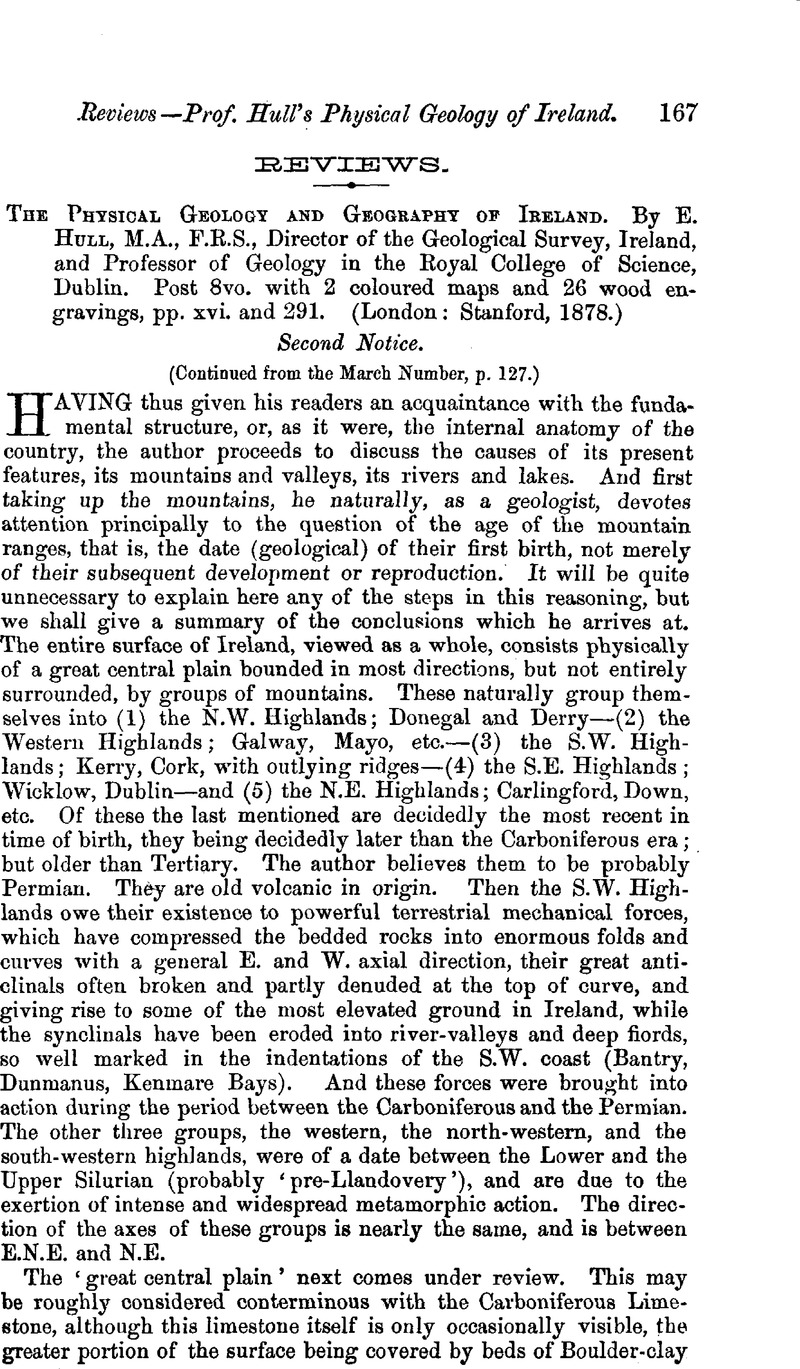No CrossRef data available.
Article contents
The Physical Geology and Geography of Ireland. By E. Hull, M.A., F.R.S., Director of the Geological Survey, Ireland, and Professor of Geology in the Royal College of Science, Dublin. Post 8vo. with 2 coloured maps and 26 wood engravings, pp. xvi. and 291. (London: Stanford, 1878.)
Published online by Cambridge University Press: 01 May 2009
Abstract

- Type
- Reviews
- Information
- Copyright
- Copyright © Cambridge University Press 1878
References
page 168 note 1 The wording of the book under review might here give rise to an erroneous idea, which however we do not think the author intends to convey. “He says,” “The extensive peat mosses . . . . are a still more recent covering (of the limestone), and generally occupy the positions of former shallow lakes” (p. 157). This would imply that they occur resting immediately on, or forming a direct covering to the limestone—in reality, we believe they never do. They occupy shallow lake-like depressions in the clays, a thin deposit of calcareous marl with fragments of shells marking the lacustrine deposits at their base, before the growth of vegetation converted the pool into a moss, or bog. We believe it scarcely possible for such a peat moss to be formed upon an open and highly porous base, such as the limestone itself would afford.
page 169 note 1 We regret that we are compelled to think that Prof. Hull has very seriously injured the effect of this telling paragraph by the concluding sentences. It is so seldom that we find any attempt at what might be called forced oratory or over-strained sentiments in Mr. Hull's matter-of-fact writings, that any departure from good taste in such a direction makes the stronger impression. The danger of using terms and expressions derived from and only applicable to intellectual beings, and their rational acts, in explanation of inorganic forces, has often been insisted on, and has here also proved to be the origin of the pseudo-scientific and false analysis of the writer. It may be perfectly true that part of the material removed from the surface of Ireland was thrown down in the British area, and may so far have contributed to the future mineral wealth of England. But when he speaks of Ireland “stripping herself to clothe her sister,” “and to supply materials for protecting from atmospheric waste her vast stores of Coal, upon which her greatness and prosperity now so largely depends;” and even goes on to exclaim “this debt ought never to be forgotten”—the writer only excites the smile of geologists and the wondering stare of others. We should not wonder, to carry out the idea further, if some of the modern Home Rulers would threaten to bring an action to recover compensation for the loss incurred by their country (countless ages before man existed at all) by this reckless sacrifice to England; while on the other hand we have little doubt that some of those who are now harassed and vexed by the obstructiveness of modern patriots would be glad to see a little continuance of the former generosity on the part of Ireland towards her poor sister, in these sadly degenerate days!! We cannot too strongly reprobate such mischievous and false attempts at sentimentality in scientific questions.
page 169 note 2 Geol. Mag. Vol. III. Dec. II. p. 556Google Scholar; Journ. Roy. Geol. Soc. Irel. vol. iv. p. 170.Google Scholar
page 171 note 1 We do not observe any notice, among the detailed descriptions of the drift deposits of Ireland, of the important fact of the occurrence of pieces of the compact Cretaceous limestone of the N.E. of Ireland in the clays of the South of Ireland, even so far south as the County of Cork.
page 171 note 2 The writer adds most naively in a note, “Of this, however, I have no positive proof,” no general returns of rainfall being available, but he says, “I have little doubt that it is the case.”
page 173 note 1 Old Procopius held that on the tops of high mountains there never fell either snow or rain, because they are above the highest clouds!! Bacon, in one of his wonderfully sententious passages, says, “Adulterina res est in scientiis præcocem esse et promptum, nisi etiam solidus sis et multipliciter instructus.”—De Augm. Scient., lib. v. cap. v.


